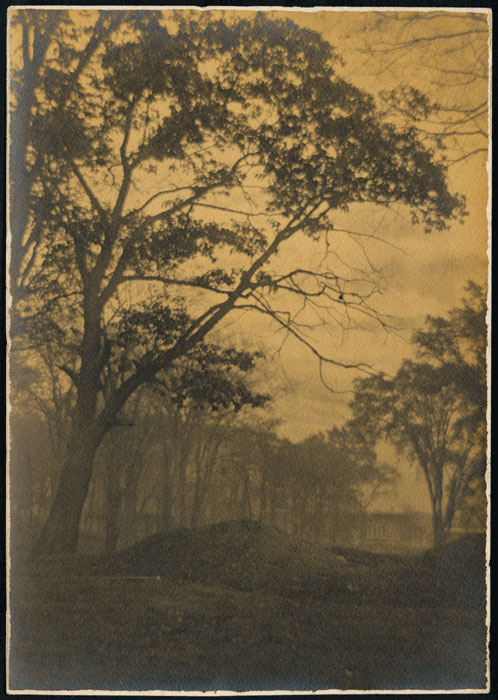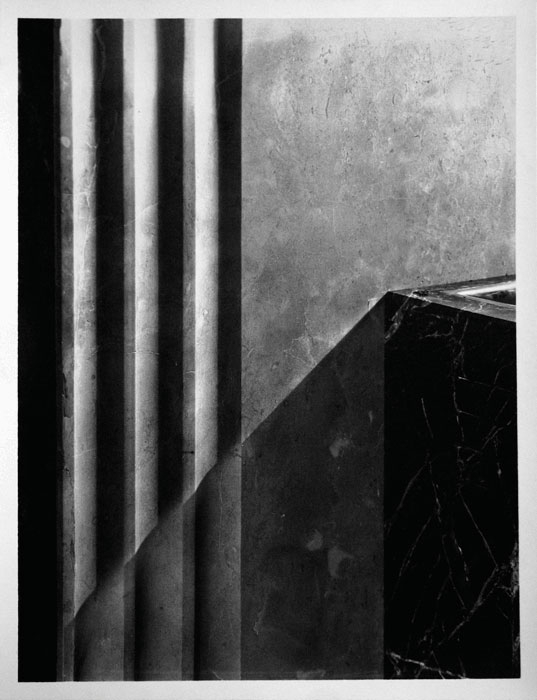[Spring-Summer 2012]
Now the artistic director of La Bande Vidéo, Sébastien Hudon has been, in turn, a bookseller, an author, a critic, and an independent curator. He was nominated for the young curator of the year award at the first agac gala following his presentation of two successive exhibitions mounted in 2010 and 2011 at Maison Hamel-Bruneau, in Quebec City: “Concerto en bleu majeur,” on the links between the visual arts and music, and “Photographes rebelles à l’époque de la Grande Noirceur (1937–1961).” He is now completing a master’s degree in art history at Université Laval, where he obtained a graduate degree in museology in 2011. Part of his collection is currently on view in Montreal in “Quelques moments d’utopie,” presented at the Maison de la culture Côte-des-Neiges until 27 May, as part of the Accès culture de Montréal network’s event Collectionner, as well as in “Travers. L’art de collectionner,” presented at the Arsenal until 25 May.
An interview by Jacques Doyon
JD: You curated the exhibition “Photographes rebelles à l’époque de la Grande Noirceur (1937–1961),” the result of original research that highlighted the aesthetic modernity of photographic practices in Quebec long before the Refus global was published. Can you tell me who piqued your interest in this undiscovered aspect of Quebec’s aesthetic history and summarize the general direction of your research?
SH: When I was a university student, just as I was starting my bachelor’s degree, we had a course in Quebec art history focusing mainly on painting. Sometimes, certain professors, such as Marie Carani, mentioned in passing that modernist groups in Montreal were interested in photography. However, it was almost impossible to see published examples, and even less to find a history of Quebec photography bringing together a coherent and complete grouping of the important works of the period. For me, it was even more inconceivable that a general history of Quebec photography didn’t yet exist after more than a century and a half of existence of the medium. And beyond that, I wasn’t able to convince myself that photography – a medium that is so accessible and highly valued by avant-garde artists on the international scene – had left no trace in the corpuses of the most prolific Quebec artists.
When we think of its fundamental importance for secessionist groups in Europe and the United States, but also for the futurists in Italy, the vorticists in England, the Dada movement in Switzerland, the French surrealists, the October group in Russia, the Bauhaus in Germany as well as the New Bauhaus later in the United States, how was it possible that aside from Jauran, and perhaps Omer Parent – of whom I knew nothing other than his name at the time – modernist photography had no representatives in Quebec? Considering how active the avant-garde groups were in all areas of artistic creation, this complete absence of photography in Quebec’s art history appalled me. And I was not alone. I began to want to find these works at that time, for the challenge, the need, and the passion.
JD: Where does your interest in photography come from? What led you to collect it?
SH: It’s a very long story. I’d say that it all began at the bookstore where I worked until just before I began my bachelor’s degree. The bookseller, Jean Dumont – who’s still in business today – had long wanted to build a major collection of Quebec photography. His extensive cultural background, paired with my curiosity and pleasure in doing research, quickly made us a complementary team. He gradually became a friend, even a mentor, encouraging my reflection and training in many areas. Together, we discovered the great international photographers (Le Gray, Baldus, Marville, Man Ray, Moholy-Nagy, Steichen, and so on); it was quite a fantastic time. I tried to obtain Quebec works for him at flea markets or antique stores, and then we discussed them. After a while, my eye became more refined and surer. Then, I began to collect all sorts of things for myself, although I didn’t have much money; I had always collected, but at that time, it was mainly works on paper – old books, manuscripts, and so on. Then Dumont introduced me to a number of people, including an extraordinary professor, Elliott Moore, who encouraged me to get a bachelor’s degree in art history. Finally, always having photography in mind, but not being able to work on Quebec photography because of the lack of sources and works, I began with a master’s degree on typography in European avant-garde publications (Dada to Zurich), which I ended up dropping.
Following a research trip to Italy, I went to visit Guy Borremans, and I wrote a short book on my meeting with him. This book, which I now think is a bit naïve and awkward in style, was nevertheless the very first one on the subject. In short, I had to start somewhere. I think that my interest in modernist photography truly began then: I wanted at any cost to find works for my own collection and for my research. There was a huge void: the entire period from 1890 to 1960 was still untapped, and I found almost no documentation to point me in the right direction. The raw material that I had amassed during my work on Borremans was disorganized: I took everything apart and went back to the research where I had left off when I wrote the book, and I got the idea to put together an exhibition on modernist photography and therefore to start my “archaeological” work again. So, I registered at the d.e.s.s. in museology, for which “Photographes rebelles” was to be both the starting point and the end point.
Then I spent many long hours looking through microfilm and online archives and thinking about artists and works, and about dates and places where the Quebec photographs had been shown. Names and paths began to appear, people who led me to meet descendants and, more rarely, the artists themselves. At the time, since almost no one had ever shown an interest in these works; I found complete collections, with everything still intact (or almost) after more than fifty years. It’s a little like lifting a sealed slab in a temple and discovering a buried treasure: the excitement of discovery has never left me since. I think that it was this enthusiasm and the fact that no researcher had bothered to be interested in photographic works as important as those by Dumouchel (fig. 3) and Mousseau (fig. 4) that stimulated the generosity of a number of people I’ve met. These people made it possible for me to acquire the most impressive works of each of the artists, but on condition that I would make them known and show them. Without their unconditional support and their great trust, none of the works in my possession today would have become known.
JD: So, your research led to the acquisition of important works. Was this your main source of finding and acquiring these works? Or have you exploited other avenues?
SH: For the acquisitions, the sources are quite broad: flea markets, garage sales, antique dealers, bookstores, art galleries, online auctions, and specialized Web sites. Other than that, photographs come directly from artists, families, and so on. The prices aren’t always very affordable, but we manage to find alternate solutions in these cases. There are still things that, when they are sincere, are priceless: loyalty, intelligence, friendship. Similarly, there are photographs that, once they are in my collection, have no price except the one assigned to them, because their value is priceless.
JD: What stimulates your desire to collect? How is your collection structured?
SH: My great dream is to provide Quebec with a structured history of photography as a means of artistic expression, integrating it with the history of international photography and yet emphasizing its specificity and significance to Quebec’s culture. This is urgent for the periods between 1888 and 1961, after which we will have to look at the preceding and succeeding periods in order to form the most exhaustive history possible.
I should say that this dream also inspires the structure of my collection, which concentrates mainly on these periods, even though Quebec photography as a whole interests me. But as theoretical discoveries are made (I am a researcher above all), certain additions change not only my perspective on the works but my general comprehension of each period. At one point, I don’t know if I’m collecting in order to better understand what I’m reading or reading in order to be a better collector. This means that I find works starting from avenues discovered in the texts, or else it is the works I find that lead me to the texts.
I’m thinking mainly here of a fantastic body of Montreal photographs on the verge of abstraction, all of them from the late 1920s and early 1930s, which I acquired recently (fig. 2). Using key words and after a number of sleepless nights, I think I’ve identified with certainty the photographer who made them, and I’ve even discovered that they were exhibited in Montreal in early 1931. In the current state of the research, these works completely upend our ideas about the premises of formalism in Montreal and put us in phase with the photographic experiments on the international scene.
As I’ve just mentioned, these works probably were shown in a large exhibition held in the Windsor Hotel on Dominion Square. This major show was organized by the Civic Improvement League of Montreal to showcase the unique character of the city as a “modern” metropolis. In the wake of the crisis of October 1929, Montreal, following the lead of a number of large American cities, had built magnificent Art Deco skyscrapers.
In the newspapers, which covered the show extensively, there was mention of “photographs effectively presenting certain abstract and angular details of the Aldred Building.” The strikingly simple and ingenious image shown here (fig. 2) is apparently the one described. We see mainly light, which has become the main subject. In fact, it seems that the effects of light divide the representation, a little like a theorem. At that time, such an interpretation of the photograph’s main quality of portraying light could come only from someone with an eye well trained to view abstract works. Moreover, was this the first work of this type to have been produced and exhibited in Quebec?
Finally, for those who want to try the experiment, it is still possible to find this exact image today. Go to the ground floor of the Aldred Building on a sunny day to find the exact spot where this shadow covers the marble!
Jacques Doyon has been the editor-in-chief and director of Ciel variable since January 2000.


![fig. 2 : Sydney Jack Hayward (1885–1956) [attr.], Théorèmes lumineux ou détail d’une corbeille en marbre à l’entrée du Aldred Building, Montréal, vers 1930, épreuve au gélatinobromure d’argent à surface mate, tirage d’époque / Light theorems, or detail of a marble grate at the entrance to the Aldred Building, Montreal, ca. 1930, silver gelatin bromide print with matte surface, period print, 23 x 16 cm](https://cielvariable.ca/wp-content/uploads/2012/04/91_97_AlbertDumouchel_img01.jpg)


